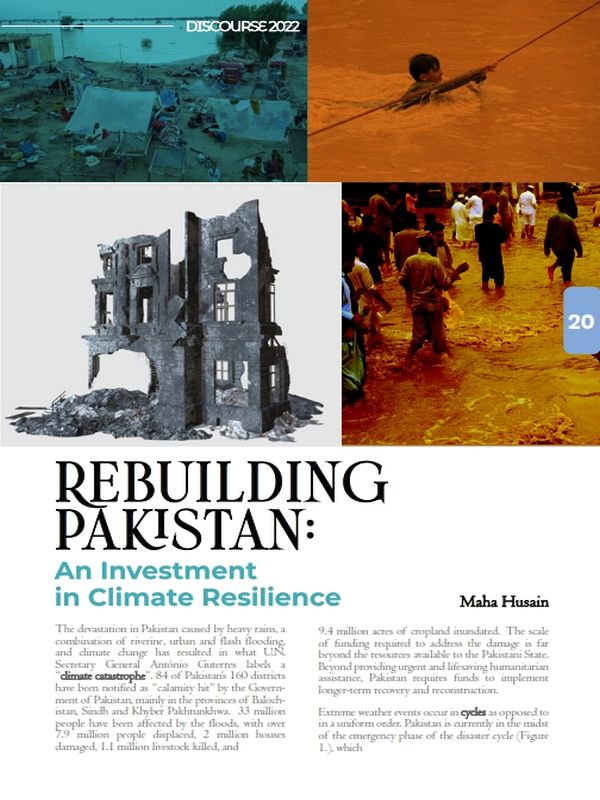
Pakistan Institute of Development Economics
- Home
Our Portals
MenuMenuMenuMenuMenuMenuMenu - ResearchMenuMenuMenuMenuMenuMenuMenu
- Discourse
- The PDR
- Our Researchers
- Academics
- Degree Verification
- Thesis Portal
- Our Portals
Rebuilding Pakistan: An Investment in Climate Resilience
The devastation in Pakistan caused by heavy rains, a combination of riverine, urban and flash flooding, and climate change has resulted in what U.N. Secretary General António Guterres labels a “climate catastrophe”. 84 of Pakistan’s 160 districts have been notified as “calamity hit” by the Government of Pakistan, mainly in the provinces of Balochistan, Sindh and Khyber Pakhtunkhwa. 33 million people have been affected by the floods, with over 7.9 million people displaced, 2 million houses damaged, 1.1 million livestock killed, and 9.4 million acres of cropland inundated. The scale of funding required to address the damage is far beyond the resources available to the Pakistani State. Beyond providing urgent and lifesaving humanitarian assistance, Pakistan requires funds to implement longer-term recovery and reconstruction.
Extreme weather events occur in cycles as opposed to in a uniform order. Pakistan is currently in the midst of the emergency phase of the disaster cycle (Figure 1.), which occurs immediately after a disaster event. This stage is followed by the compensation and insurance, and rebuilding phases which aim to return the affected community back to normal. Next, the risk mitigation phase deals with pre-disaster mitigation to reduce the impact or likelihood of the extreme weather event before it takes place. The emergency phase tends to gather the most media and government attention of all the disaster phases due to the visibility of destruction and results. The rebuilding and reconstruction phase is often overlooked by both governments of affected States and States providing emergency funds. This article suggests that Pakistan must focus on and invest in all stages of the disaster cycle, especially the rebuilding phase, as this can serve as a disaster-management tool for future disasters. In addition, the article will explore avenues to fund the rebuilding stage in Pakistan after the 2022 floods.
Flood Impact Assessments traditionally comprise of three costs: (i) direct damage, (ii) indirect losses and (iii) reconstruction cost. In collaboration with the United Nations, the Pakistani government has issued an appeal for $160 million in emergency funding to cover part of the direct damage and indirect losses caused by the 2022 floods. Reconstruction funding, however, has not yet been collected as Pakistan is still in the emergency phase of the disaster cycle. Reconstruction costs involve rebuilding lost assets and restoring lost services and are calculated using the replacement value of assets and infrastructure lost. According to the Finance Division’s Flood Impact Assessment Report, the reconstruction cost for the 2010 & 2011 floods was estimated to be $2.7 million. It is likely that the reconstruction cost for the 2022 floods will far exceed the value calculated in 2011, as the scale of the destruction this year is said to be the worst that Pakistan has ever experienced.
To bridge this funding gap, Pakistan may consider appealing to the international community to fund rebuilding efforts by arguing that developed States have an obligation to financially support reconstruction projects in disaster-prone developing States. This obligation stems from the no-harm rule and the polluter-pays principle in customary international environmental law. Customary international law has already established this obligation with respect to financial support for early warning mechanisms in disaster-prone developing States. The same argument can justify funding reconstruction projects if reconstruction is reframed as a preventive measure. The Sendai Framework uses this reframing in its “build back better” priority for 2015-2030. “Build back better” refers to using the reconstruction phase to integrate new technologies and building methods to increase resilience and protect against future disasters. The no-harm rule stipulates that no State has the right to harm another State during the exploitation of its own resources. However, States, especially Developed nations and emerging economies, have failed to lessen the impacts of transboundary harm with their uncontrolled exploitation of natural resources. Given that financial support for early warning systems falls into the classification of “preventive measures”, reconstruction in the form of building back better can also fall into this category.
Similarly, the polluter-pays principle, which stipulates that polluters should bear the costs of managing pollution, can be used to fund reconstruction in disaster-stricken States. This is because GHG emissions are considered a form of pollution because of the potential damage they cause through impacts on the climate. Using the analysis above, it can be argued that high-emitting countries and carbon majors are obligated to fund reconstruction projects in disaster-prone States.
Therefore, Pakistan must advocate for the international community and carbon majors to fund reconstruction after the current flooding. To make this process as effective as possible in building back better, it is suggested that Pakistan:
- create and operationalise a recovery and reconstruction authority under the National Disaster Management Authority (NDMA);
- increase coherence between existing disaster management policies produced by the NDMA and all Provincial Disaster Management Authorities;
- increase coordination among stakeholders in Post-Disaster Recovery (PDR) activities to allow a smooth transition of recovery; and
- place building community resilience at the centre of the recovery process.
The author is the Team Lead, Climate & Environment Initiative (CEI) at the Research Society of International Law (RSIL)



